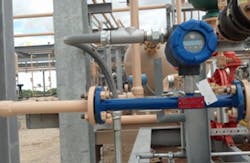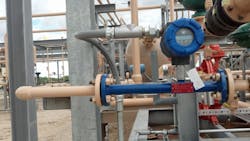Emissions Monitoring Applications Propel Thermal Flowmeter Market
Here a Magnetrol flow-body (spool-piece) type inline sensor measures natural gas for an exploration and production company. (Photo courtesy of Magnetrol International)
A new age of environmental awareness, together with the Kyoto Accord and other greenhouse gas initiatives, has resulted in a rewriting of the rules on measuring greenhouse gas emissions. There is suddenly a need and demand to measure greenhouse gases in applications that formerly may have gone unnoticed. Many of these applications present opportunities for thermal flowmeters, which are mainly used to measure gas flow. Flow Research estimates the market for thermal flowmeters totaled $154 million in 2013, and is projected to grow to almost $200 million by 2018.
In the early 1990s, new environmental regulations began requiring companies to detect and reduce the emission of sulfur dioxide (SO2) and nitrous oxide (NOx) into the air. SO2 and NOx are two principal causes of acid rain. The Environmental Protection Agency (EPA, www.epa.gov) initiated a program to reduce pollution in the atmosphere. It is possible to determine how much of these substances are released into the atmosphere by combining a measurement of the flowrate with a measurement of the concentration of SO2 and NOx. EPA regulations have resulted in the development of an entire industry around the introduction of Continuous Emission Systems (CEMs).
In response to CEM requirements, thermal flowmeter companies developed multipoint thermal flowmeters. In many cases, continuous emissions monitoring occurs in large stacks that emit pollution from industrial sources. Single-point thermal flowmeters measure flow at a point, making it difficult to accurately compute flow in a large pipe or smokestack. Multipoint thermal flowmeters measure gas flow at multiple points, and use these values to compute flow for the entire pipe, duct, or stack. Some multipoint flowmeters have as many as 16 measuring points.
READ ALSO:
- Energy and Large-Pipe Applications Drive Coriolis Technology to New Heights
- Differential Pressure Maintains a Powerful Place in the World of Flow Measurement
- Magmeters Top the Flowmeter Market In Revenue
- PD Flowmeters Poised to Gain from Oil & Gas Application Opportunities
- Turbine Flowmeters Remain Competitive in Turbulent Market
- Custody-Transfer Applications Drive Ultrasonic Flowmeter Growth
- Vortex Flowmeters Prove Their Worth In Steam Flow Measurement
While the need for CEM is ongoing, the 21st century has brought new environmental awareness and requirements. Scientific thinking has evolved substantially in the past 10 years. While global warming and the need to reduce carbon emissions were once viewed as scientific theory, they are now widely accepted as scientific fact. And in the United States, the federal government has made a commitment to reduce greenhouse gas emissions 80 percent by 2050. The current administration is also pledging to make the United States a leader in climate change.
It is not only the United States that is working to reduce greenhouse gas emissions. The Kyoto Accord, an international treaty designed to reduce greenhouse gas emissions worldwide, resulted in the creation of several mechanisms that require measurement of greenhouse gases. These include Certified Emission Reductions (CER), which allow carbon emitters to gain credits for carbon emitted elsewhere. Another program is the Clean Development Mechanism (CDM), which allows countries to invest in sustainable development projects that reduce emissions in developing countries.
The new age of environmental awareness is presenting major opportunities for thermal flowmeter suppliers through many new applications for thermal flowmeters, which include measurement and recovery of landfill gas, biomass gasification, measuring and monitoring of flare gas flow, and recovery of methane from coal mines. These and other greenhouse gas-related applications will help propel the thermal flowmeter market into significant growth over the next several years.
To read more about Flow Research’s latest research on thermal flow measurement, visit www.flowvolumex.com.
About the Author
Jesse Yoder
Jesse Yoder, Ph.D., is president of Flow Research Inc. He has 30 years of experience as an analyst and writer in instrumentation. Yoder holds two U.S. patents on a dual-tube meter design and is the author of "The Tao of Measurement," published by ISA. He may be reached at [email protected]. Find more information on the latest study from Flow Research, "The World Market for Gas Flow Measurement, 4th Edition," at www.gasflows.com.

